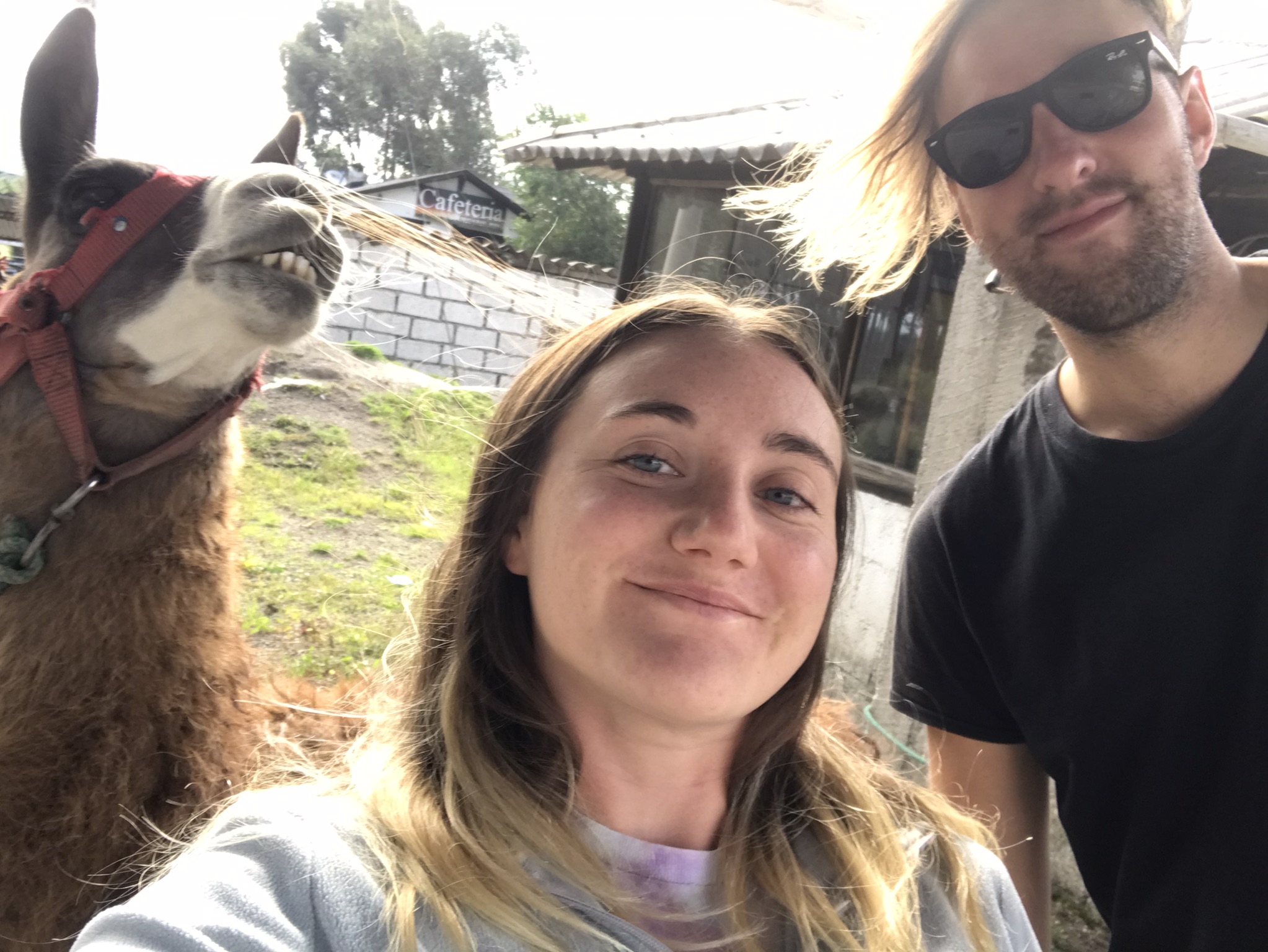Bolivia was a breath of fresh air after our stressful time in Peru. At that point we were just happy for a relatively stable country and the freedom to move around without the hindrance of road-blocks. We were delighted to discover that, unlike in Peru, there were no street hasslers or pushy sellers. Of particular interest were the women wearing traditional dress including an oversized top-hat and polleria (long, puffy skirt). We found Bolivia to be relatively untouched/untainted by the commercialism of tourism, much to our delight. Check out our Bolivia travel experiences below!
La Paz, Copacabana, Isla del Sol, Sucre, Potosi, Uyuni
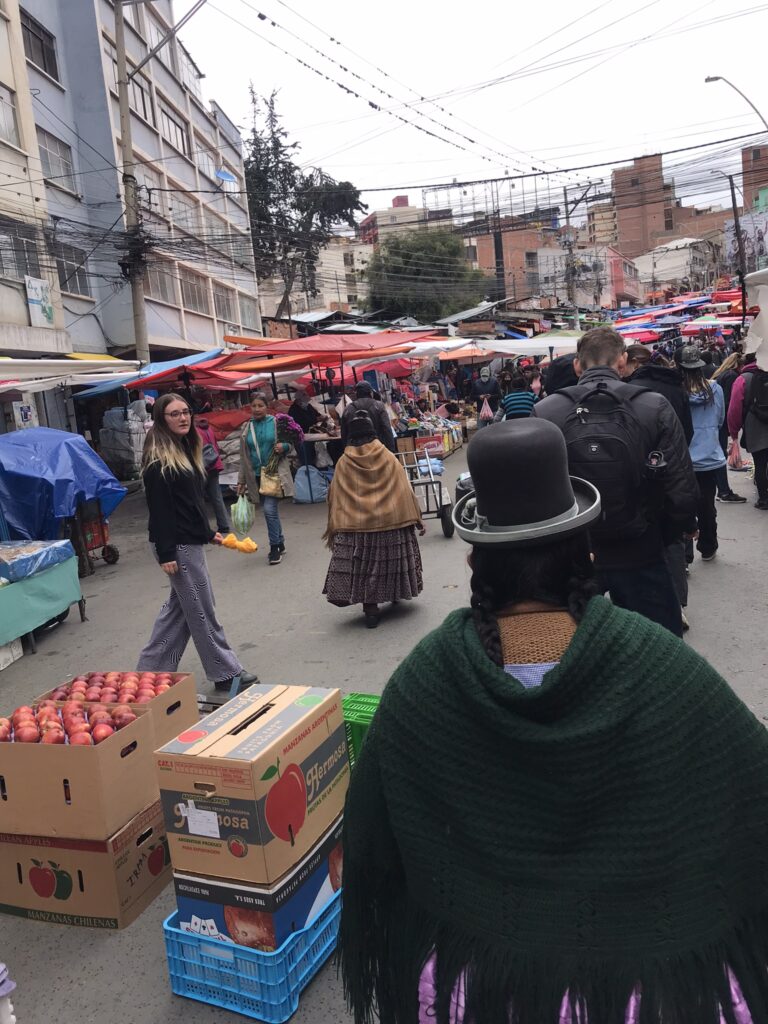
Market day in La Paz
Fee free ATM: Mercantile Santa Cruz. You can choose to withdraw either USD or Bolivianos, this was very handy as we were trying to gather as many dollars as we could before heading to Argentina. We found that paying with card was difficult in Bolivia and most places only took cash, so stock up at the ATM before any day trips or travel.
Downgrade your expectations when it comes to hostels and hotels in Bolivia. We found most of the accommodation that we stayed in had very outdated decor with broken fixtures and unexplained stains, although it’s important to note that we stayed in accommodation on the cheaper end of the spectrum. Either way, you probably won’t find crisp white bed sheets and Egyptian cotton towels here if traveling on a budget. Food hygiene standards are also not always the best, be careful where you eat and check the reviews beforehand – we played it safe with the places we ate and were not sick.
La Paz
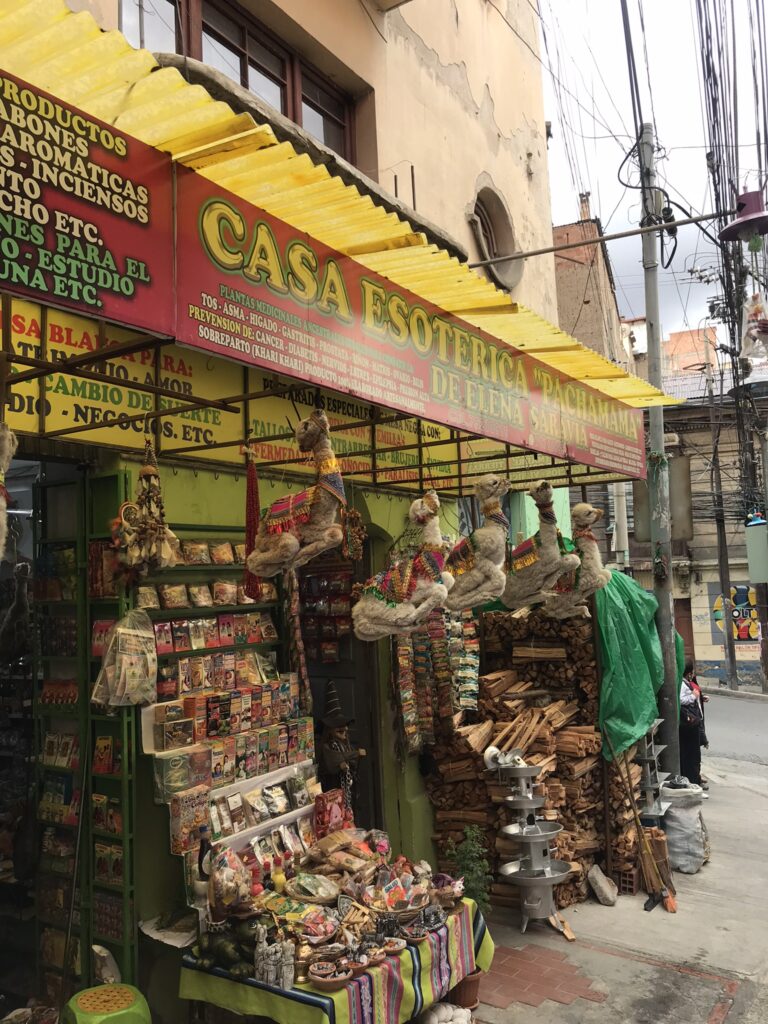
Bolivia has a mix of traditional Catholic and Andean folk beliefs – in the Witches Market you can find dried llama foetuses and witch doctors
After stepping out of the taxi from the airport we were met with a bustling and chaotic city, totally different from some of the more Europeanesque cities that we had recently visited like Cuenca and Arequipa. Maniac drivers and meandering pedestrians flooded the roads in La Paz. Be prepared for the altitude – El Alto, which sits side-by-side with La Paz is the highest city in the world. Take it slow in your first couple of days to acclimatize to the altitude if you aren’t used to it.
Accommodation
Incas Room Hotel – okay for the price. Dan fell down the stairs here, immediately after Dan fell down the stairs and ended up with a severely swollen ankle we went on a day trip to Tiwanaku; as you can imagine it was a painful experience for Dan.
Foodie Places
- The Carrot Tree – good burgers and vegan/veggie options, top floor has the best views
- YATI Restaurant café bar
- Mozzarella – this became our go to place to eat out, we were impressed by the quality of the pizzas and pasta here as well as the price!
Activities
We usually book free walking tours where available, however in La Paz this wasn’t possible, the tours ask that you pay a small price (approx. $3-4) per person beforehand. This walking tour included the The Witches’ Market (keep an eye out for the llama foetuses) and San Pedro Prison – it was super interesting to hear about this place, according to our guide the prisoners used to offer tours and overnight stays here, the prison is run completely by the prisoners with restaurants, barbers, any business you can imagine inside. We were warned not to go inside as it’s no longer safe for foreign visitors and many have been scammed or trapped in the prison. The prisoners have to pay rent for their cell and their wives/family actually live with them in the prison, which is a very alien concept to me. The prisoners work and their main industry now is drug production, especially cocaine, coca leaves are smuggled in and processed cocaine is thrown over the walls or smuggled out.
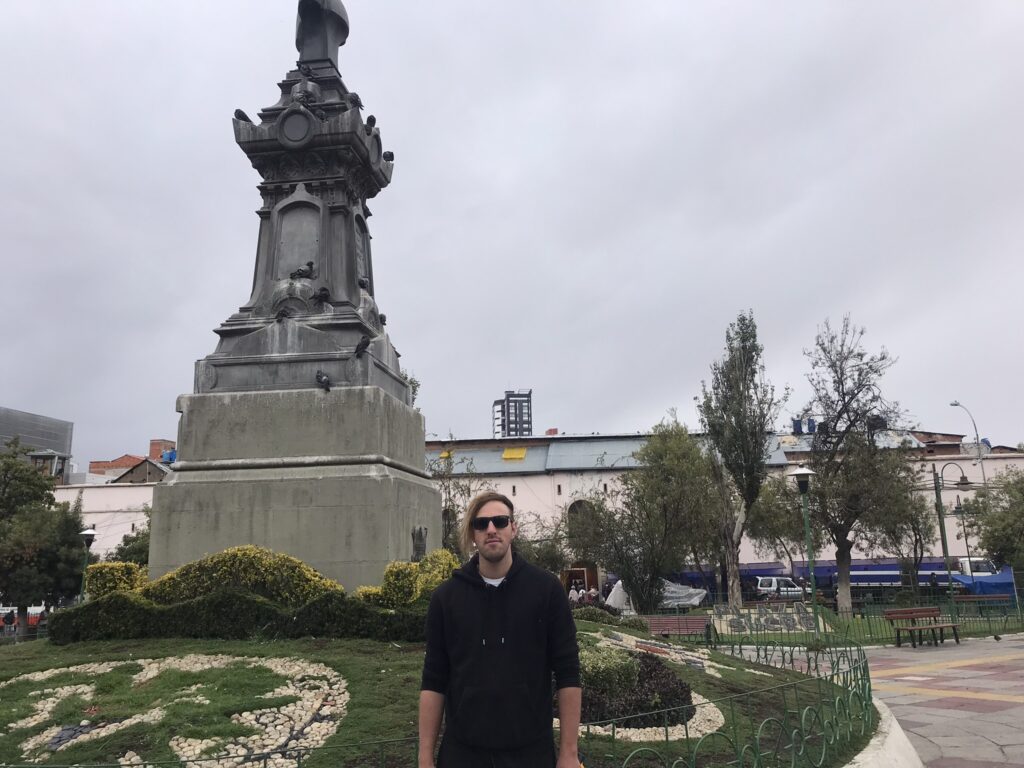
Dan and San Pedro Prison, mind your head for drug packages being thrown over the walls
Cholitas Wrestling – usually on Thursday and Sundays, you can book through your hostel, online or with a tour agency. This is WWE-style pro wrestling, I highly recommend the experience even if you’re not into wrestling. You’ll quickly find yourself cheering or booing along and picking a favourite wrestler. The Cholitas are women who wrestle in traditional Bolivian dress, they can be vicious fighters and move as if unhindered by their archaic dress. You can buy beer (very overpriced) and get a free small souvenir as part of the package, and most of the tours provide hotel and hostel pickup and return. Our experience was a bit surreal as the wrestling took place in what looked to be an abandoned gymnasium with 50 or so locals and gringos in white plastic chairs in a circle around the ring. Some of the crowd wore lucha masks too!
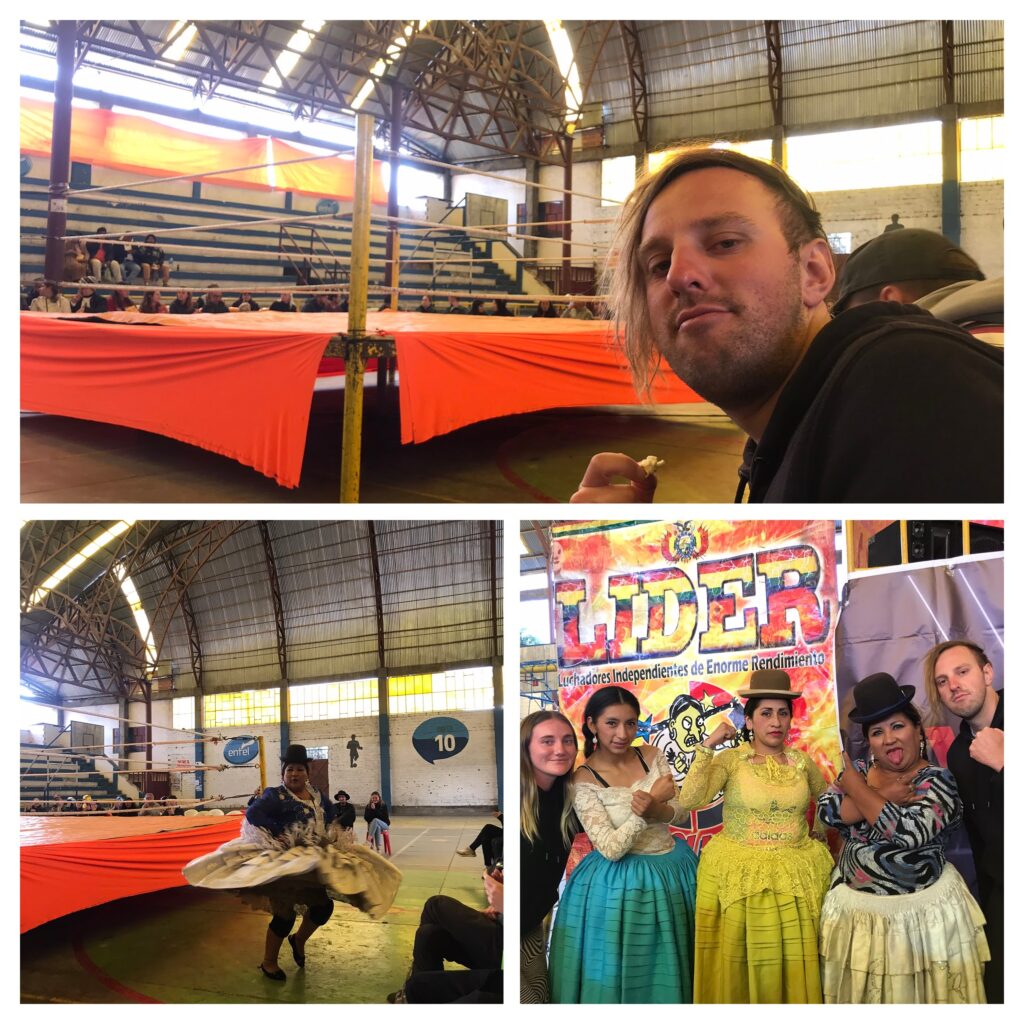
I really admire these ladies for the way they take slams on the rickety wrestling ring floor (made of actual wooden boards covered with a tarp), their pain threshold must be immense.
Tiwanaku – an archaeological site shrouded in mystery, nobody knows how it was built and there are a lot of conspiracy theories about ancient aliens surrounding this place. If you’re a history nerd like me this should definitely be on your to-do list, the skulls designs in the wall were very eerie, almost alien-like.
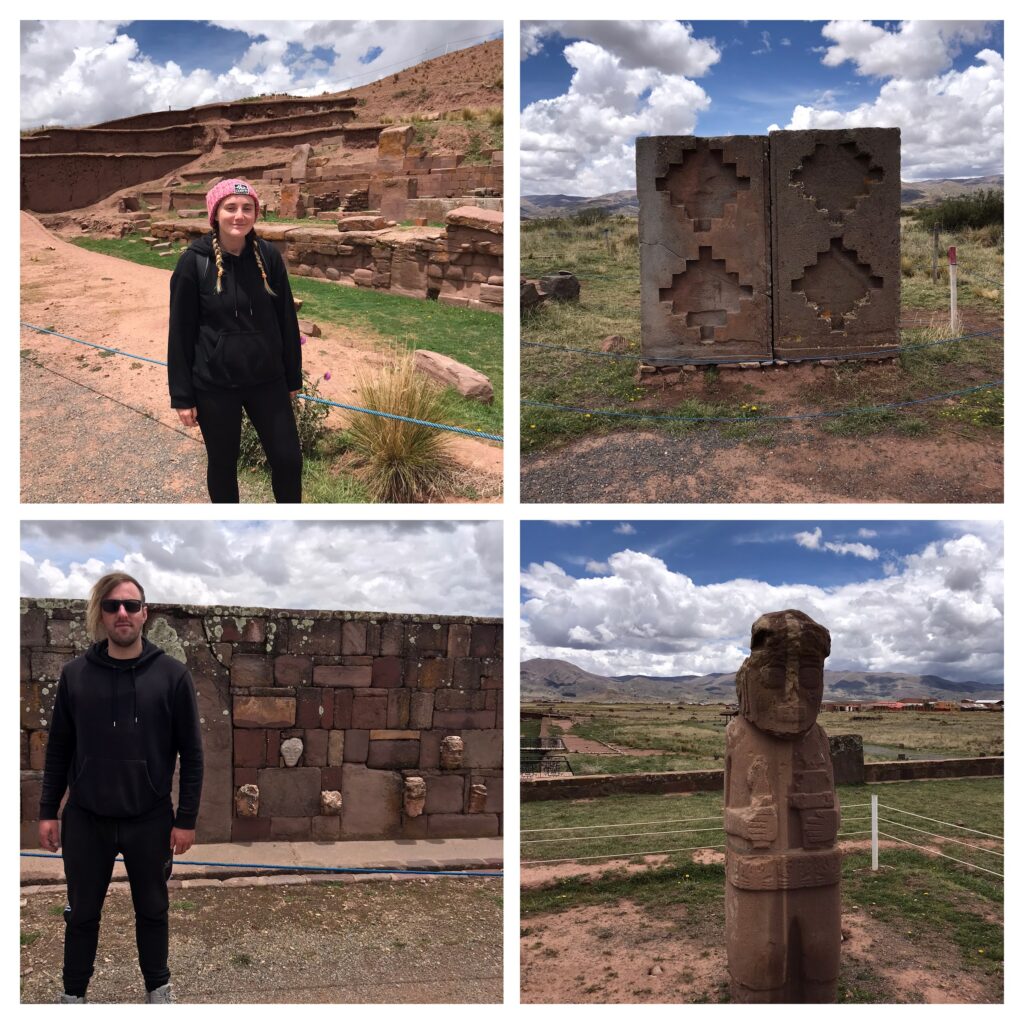
Group tour to Chacaltaya and Moon Valley – Chacaltaya is a somewhat creepy old abandoned ski resort, you can climb to the top of the peak overlooking the ski lodge, 5400m above sea level. We visited on a cloudy day so visibility was limited (although this made it very atmospheric), however we saw photos of the view on a clear day and it looked awesome. The road to the ski lodge is referred to as the ‘death road’ – all I can say is that I made the mistake of sitting at the front of the minibus and could see through the door how close to the edge of the road we were, our guide told us to close our eyes and this is the best advice I could give, it was particularly treacherous for us as the road was icy!
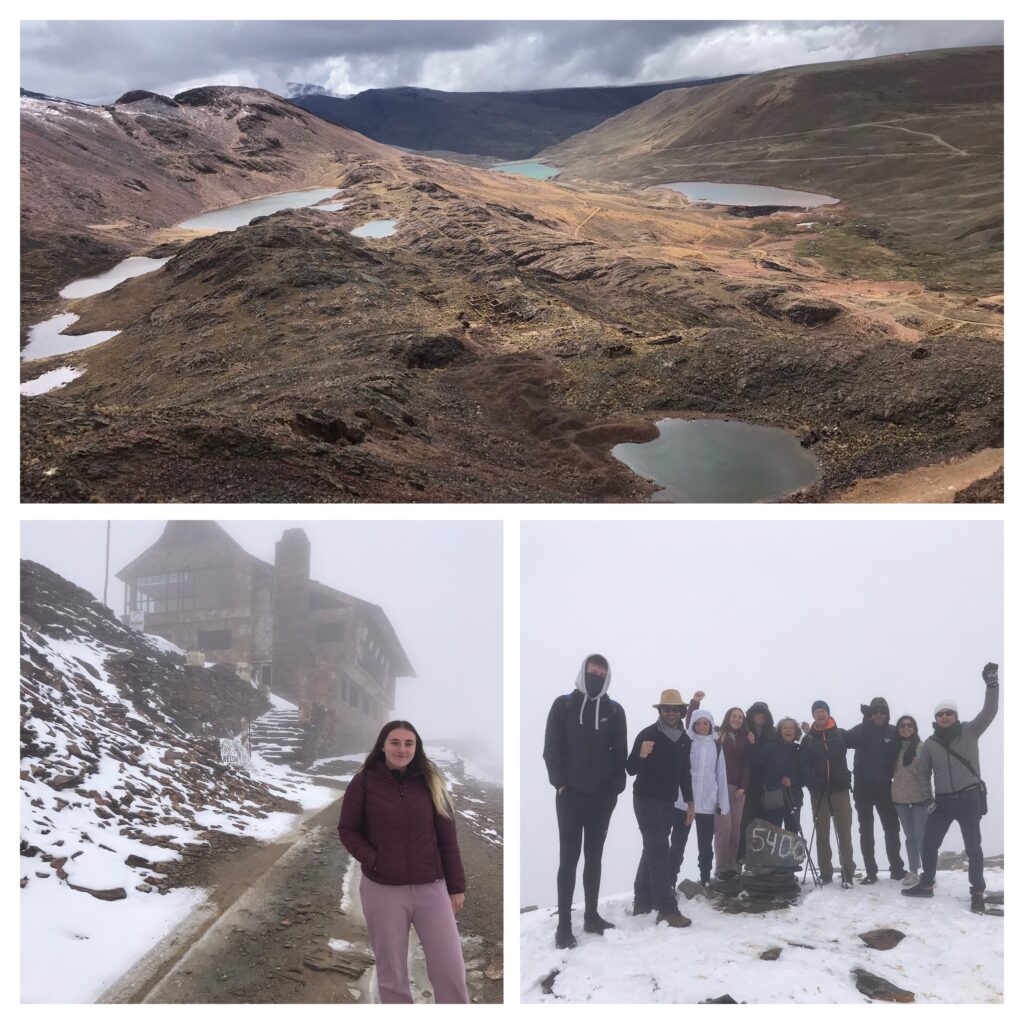
Be prepared for a steep, slippery, uphill climb to the top at Chacaltaya
Moon Valley had interesting rock formations with similarities to the moon’s surface, hence the name.
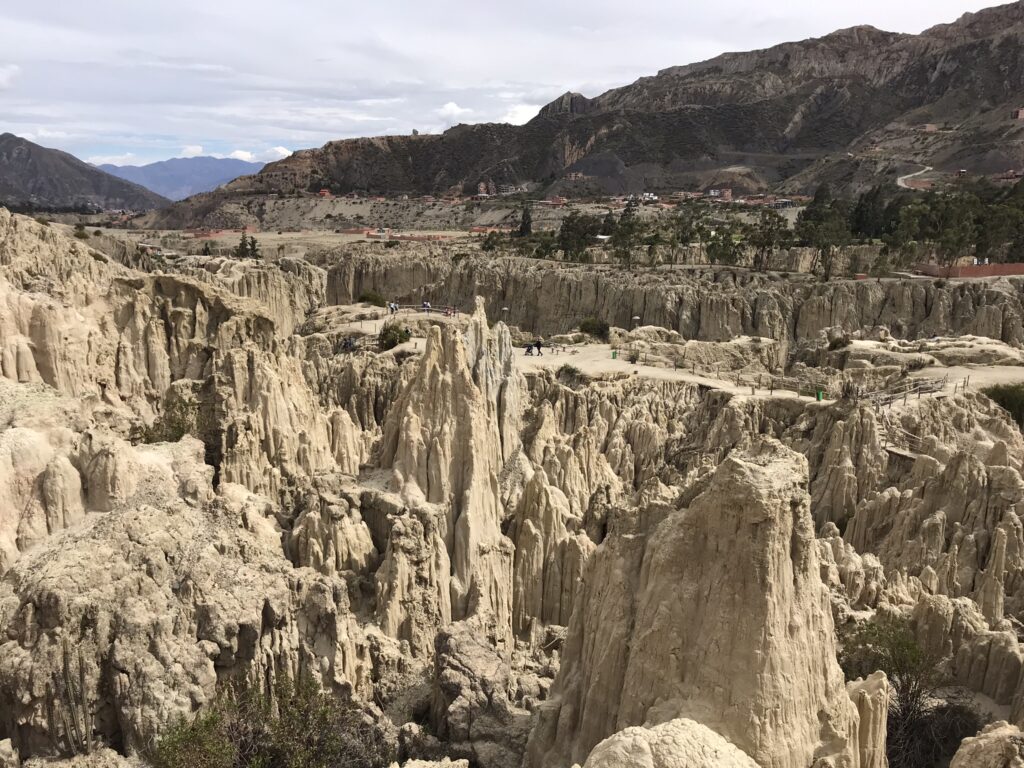
Some locals say that they can hear spirits here at night
Ethnography Museum – a good place to see traditional artefacts and skills such as weaving, we particularly liked the mask section, here there were about 30 masks all made for folk festivals, garish, weird and wonderful.
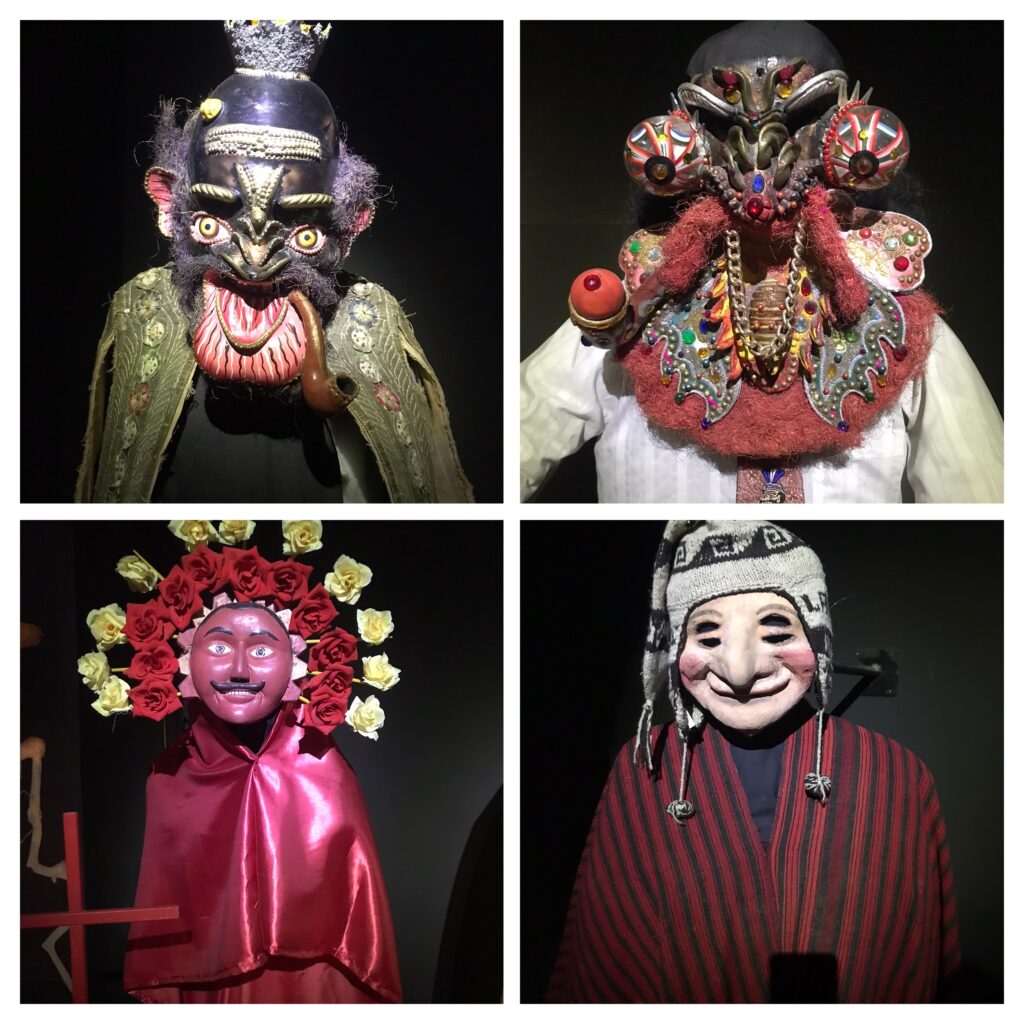
I definitely don’t want to visit the Ethnographic Museum at night!
Copacabana
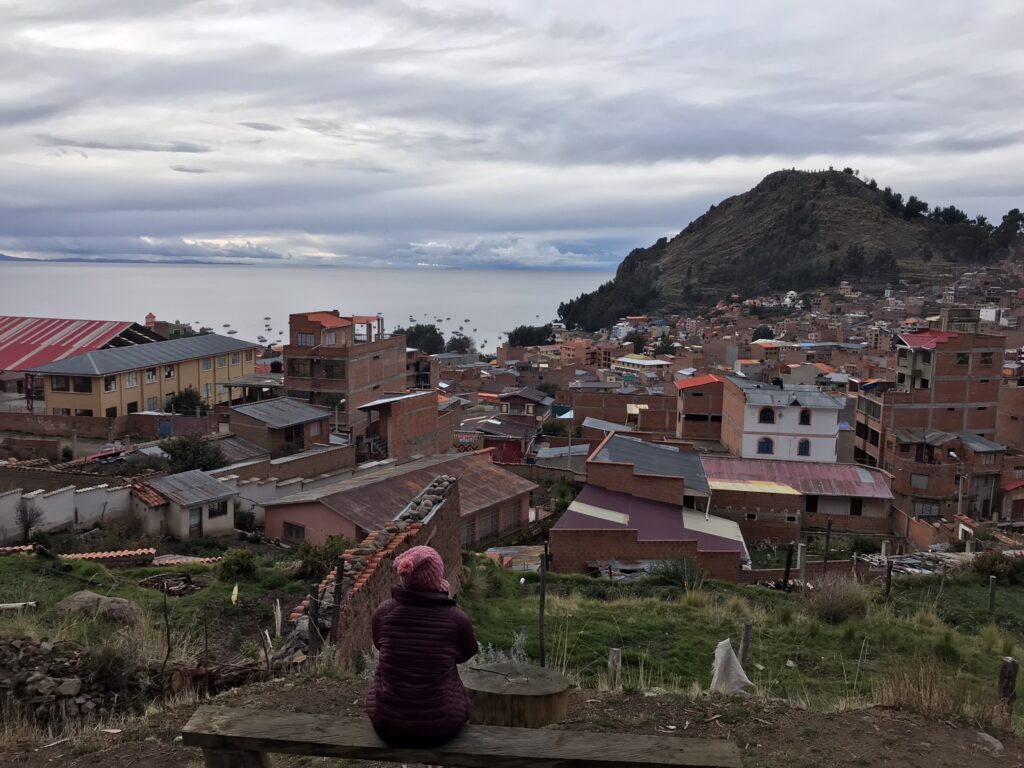
Copacabana is a small town close to the Peruvian border on the shores of Lake Titicaca, it has some attractions in itself but is mainly a transit hub for tourists heading to Isla del Sol. You can easily get here by bus from La Paz, the bus involves a short ferry crossing of Lake Titicaca at San Pablo De Tiquina where you disembark, head across the lake with the other passengers on a small boat and then can watch the bus floating across on a bus-sized raft – pretty cool! You will need to buy a ticket at San Pablo De Tiquina for the boat crossing so bring a little extra cash, although it is very cheap.
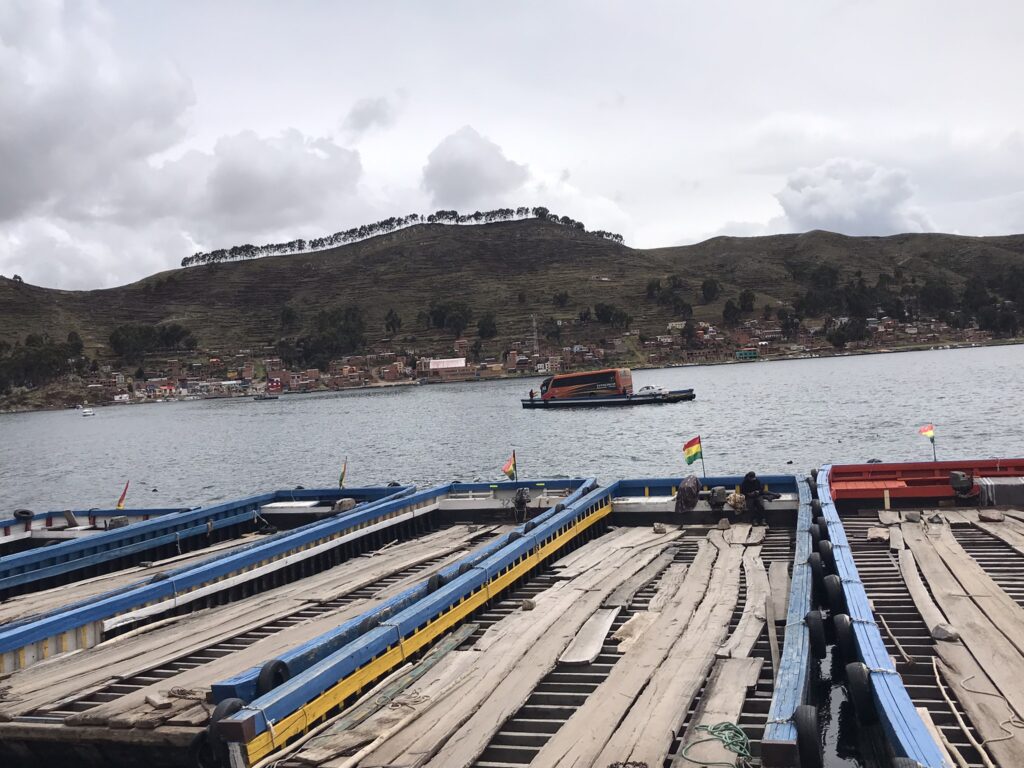
All passengers have to disembark the bus as it’s transported separately on a floating long boat pictured above.
Accommodation
Mia Posada booked via Airbnb – fantastic option with Netflix and a shared kitchen
Foodie Places
- Pit Stop – egg-cellent fried eggs and bacon on toast here
- Baguette about it – very close to where the buses leave for La Paz, we grabbed a sandwich for the journey and weren’t disappointed, huge fresh sandwiches at a great price
- Ali – great lasagne, we came here twice during our short trip
Activities
- Mirador del Inca – this is a hill containing Inca terraces, we walked up here from the town centre as far as possible, you have to pay to go to the very top but we were happy to just enjoy the view from high up.
- Basilica of Our Lady of Copacabana – this is a monumental church that dominates the town centre in Copacabana. Pilgrims come here to get their cars blessed which is said to prevent accidents (definitely needed on the Bolivian roads!), there were also several processions and other wild religious proceedings that seemed to be happening during our time here.
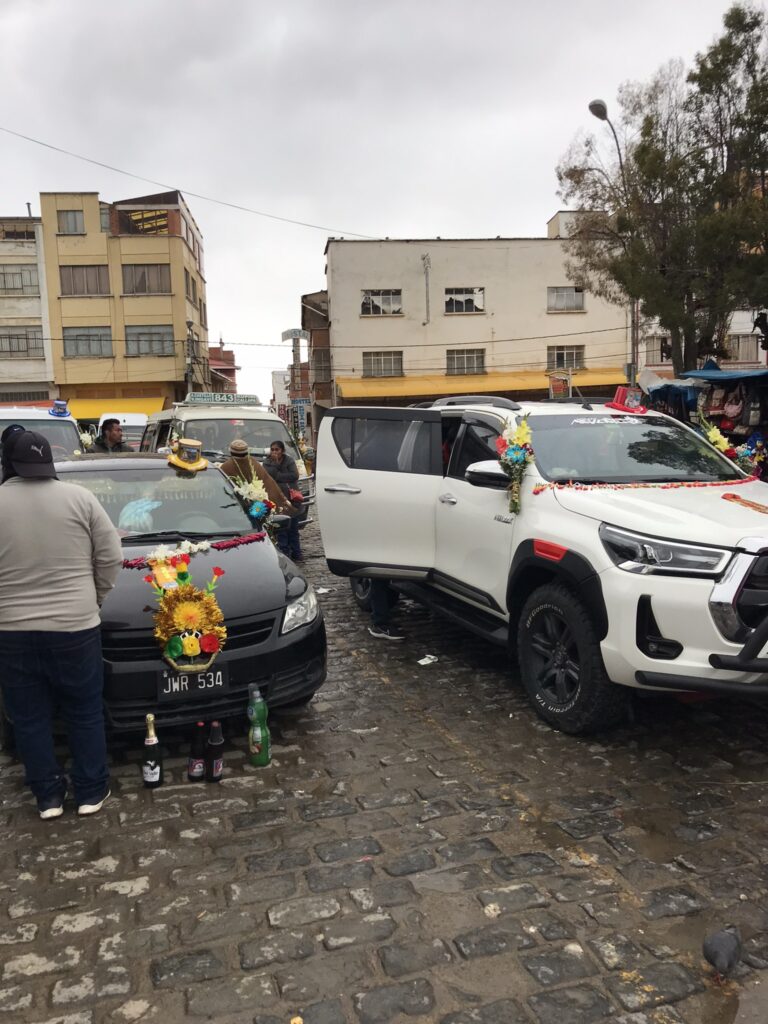
Bolivians travel to Copacabana to get their annual car blessing at Our Lady of Copacabana
- Cerro Calvario – this hill has a small sanctuary at the top and provides great 360 views of Lake Titicaca on a clear day, but is quite a climb, you’ll be out of breath at the top
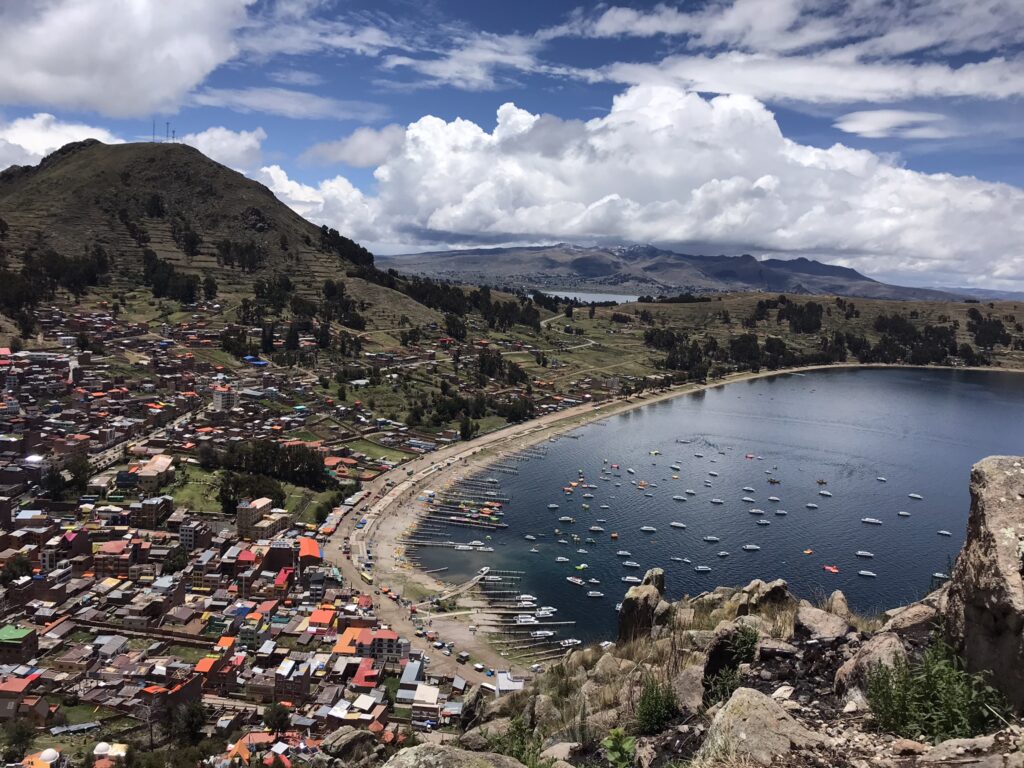
Impressive views from the top of Cerro Calvario
For most people though, Copacabana is known as the gateway to Isla del Sol, the mythical birthplace of the Incas.
Isla del Sol
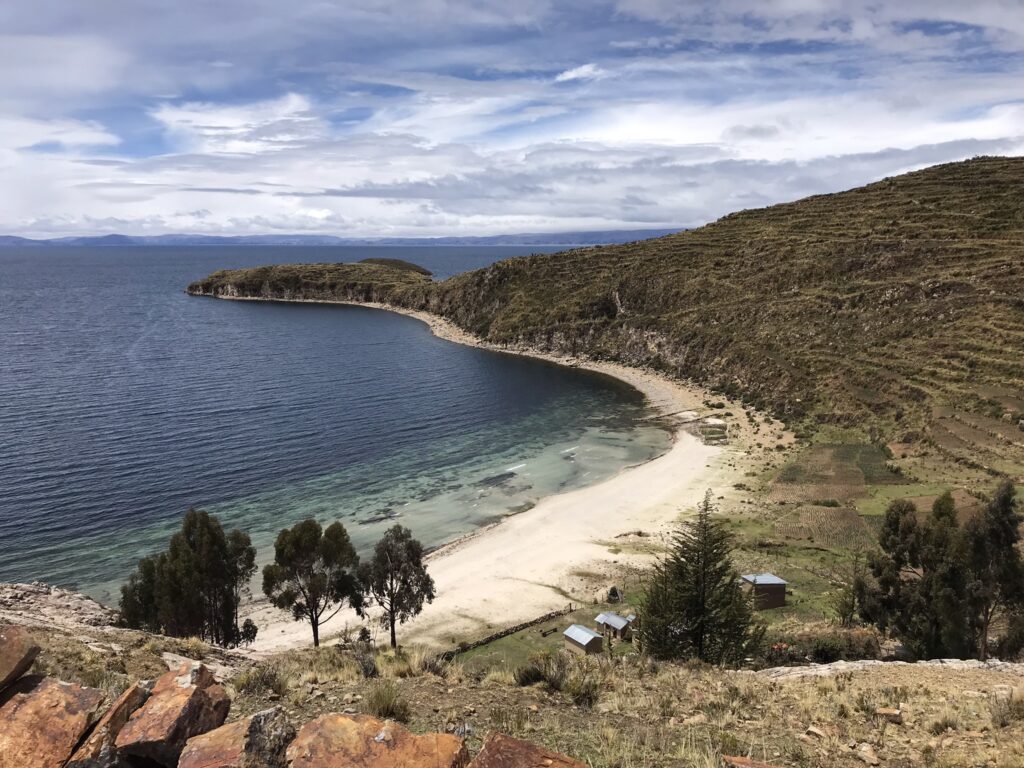
Isla del Sol, a bucolic, pastoral haven with pigs on the beach, donkeys on the stepped terraces and a slow, relaxed pace of life for the residents. Beautiful secluded beaches, impressive views of Lake Titicaca and the birthplace of the Inca sun god alongside the archaeological remains of temples.
When heading to Isla del Sol from Copacabana there are two stands at the waterfront where you can buy boat tickets to Isla del Sol. You can either get the boat to the north (Challapampa) or south (Yumani) of the island, Yumani is the bigger settlement with the most frequent crossings and where most people will base themselves if they are staying on the island. It’s worth speaking to the guys at the ticket booths to check out the boat timings when you first arrive at Copacabana, we got up very early to try and get the first boat to Yumani only to find that we were waiting around for a couple of hours before any boats actually departed, much to our chagrin!
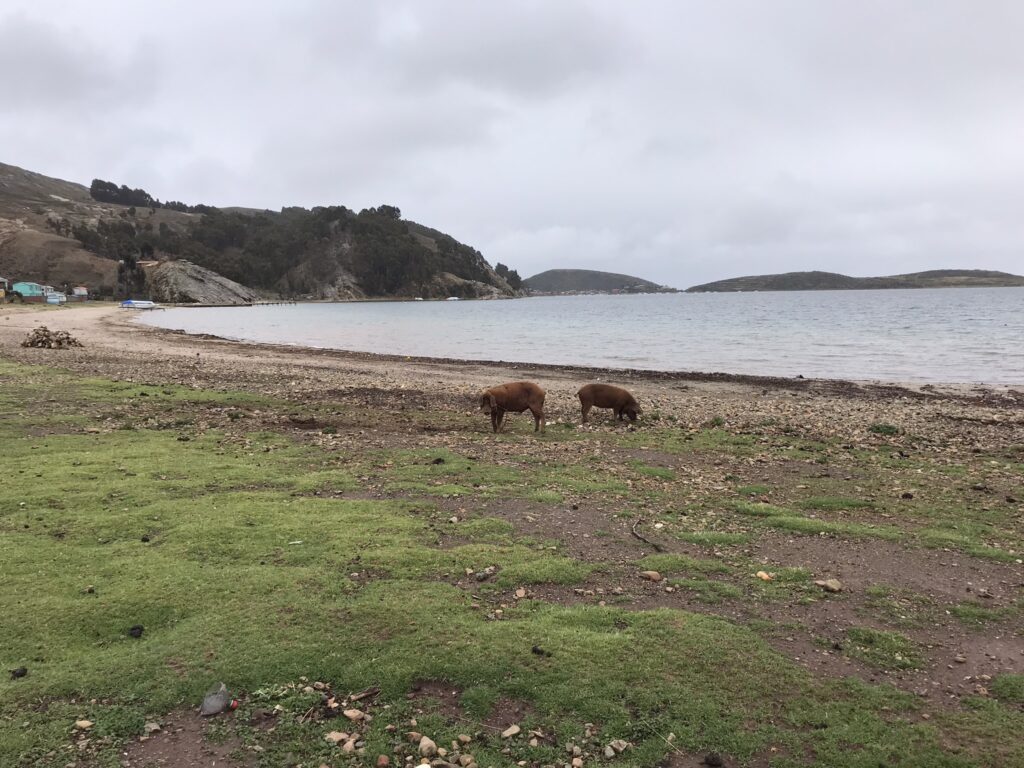
It’s not everyday you get to see pigs on the beach
When we arrived at Yumani we climbed the famous Inca Stairs and then started off on a trek to the northern point of the island, passing through green landscapes covered in Inca terraces, tiny local communities and secluded beaches including a beach with pigs. I think we veered badly off the track at one point and had a pretty steep unplanned downhill scramble but we eventually reached Challapampa, and then continued a little further north to get to Roca Sagrada, the sacred archaeological site containing the stone from where the Inca sun god Inti was said to have emerged, giving rise to the Inca civilisaion. There was a small entrance fee to access Roca Sagrada, so make sure you have cash.
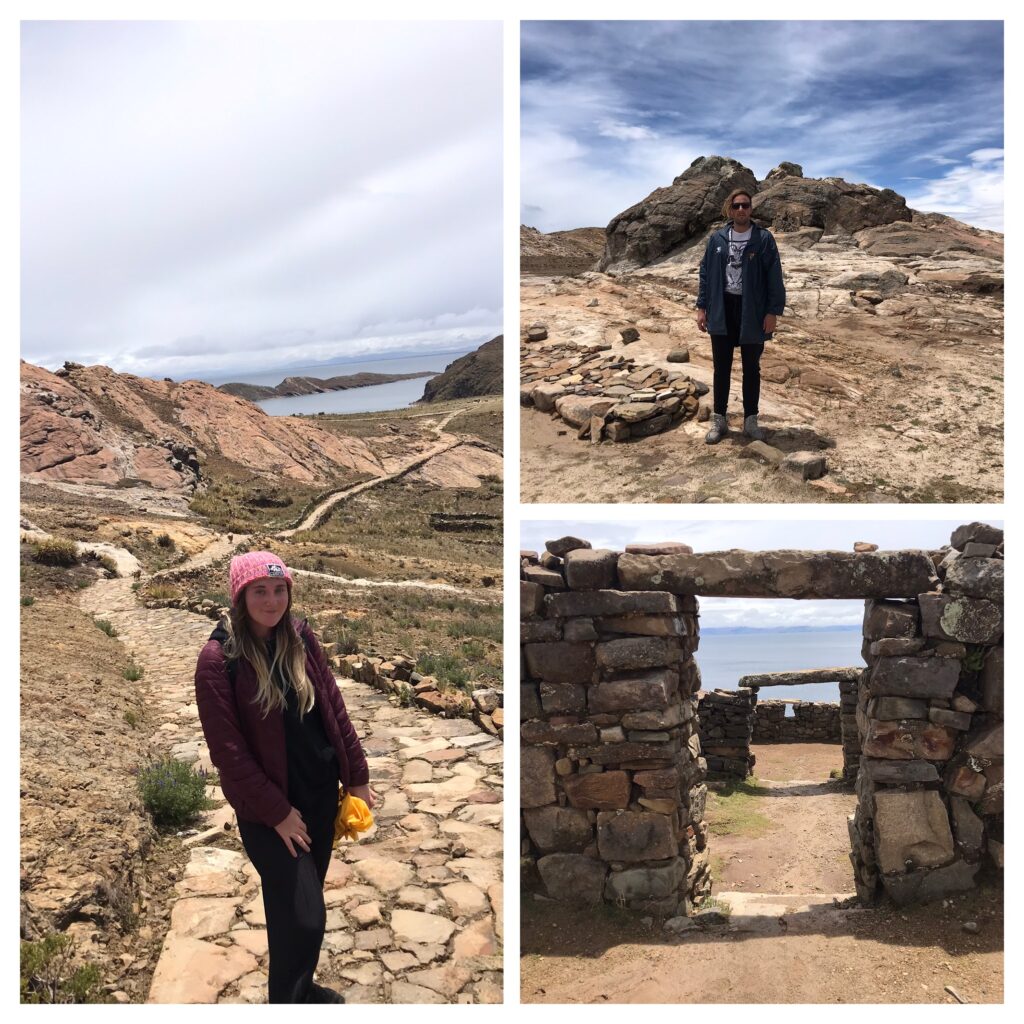
Roca Sagrada is believed to be the birthplace of the sun-god
We had planned to get a boat back to Yumani from Challapampa and then take the last boat back to Copacabana from there. However we missed the boat at Challapampa and had to resort to bargaining with a passing local to give us a lift back to Yumani on his boat, which thankfully worked. We felt like a broke version of James Bond with a private speedboat all to ourselves, however you might not be so lucky so give yourself enough time! We’d resigned ourselves to spending a night on the island unplanned, however that wasn’t to be and we made it back to Copacabana in once piece.
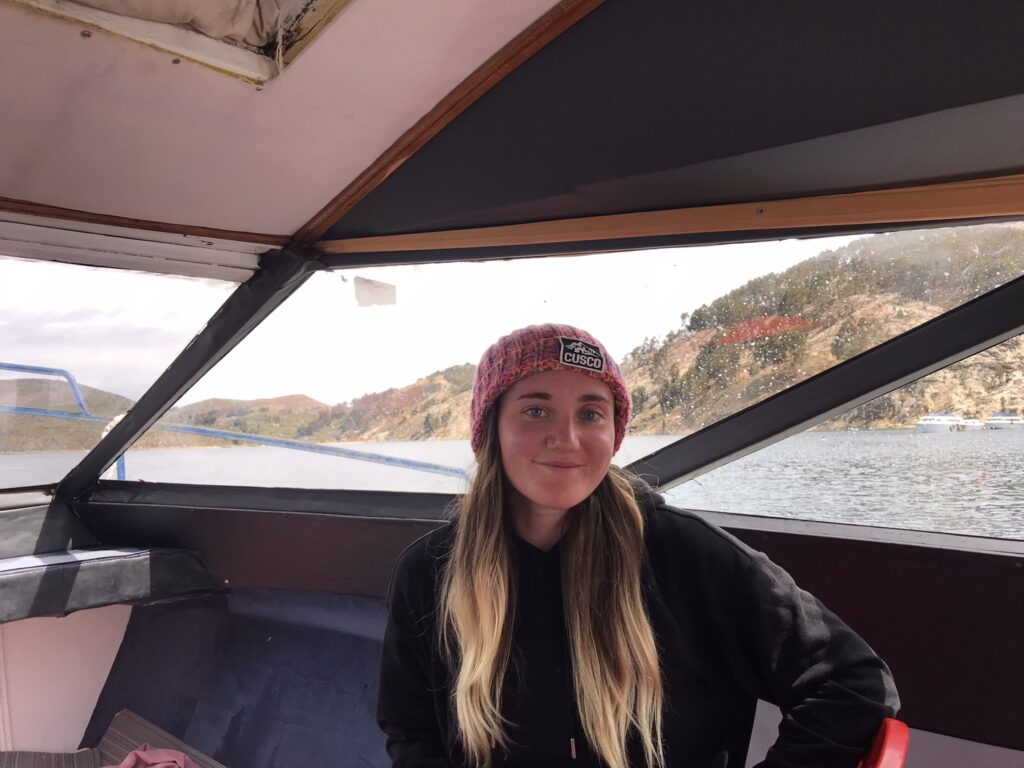
We had to blag a private boat back to the port as we missed the last boat back to Yumani
I really recommend spending at least one night on the Isla del Sol. We didn’t do this and really had to rush to pack everything into one day. Our plan was to spend a couple of hours on the island and return to Copacabana however we didn’t feel like we got the full experience that staying on the island would provide. We also spent most of our time worrying about missing the boat, which we eventually did.
Click here for an ideal itinerary for Isla del Sol and Copacabana heading from La Paz based on the mistakes we made.
Sucre
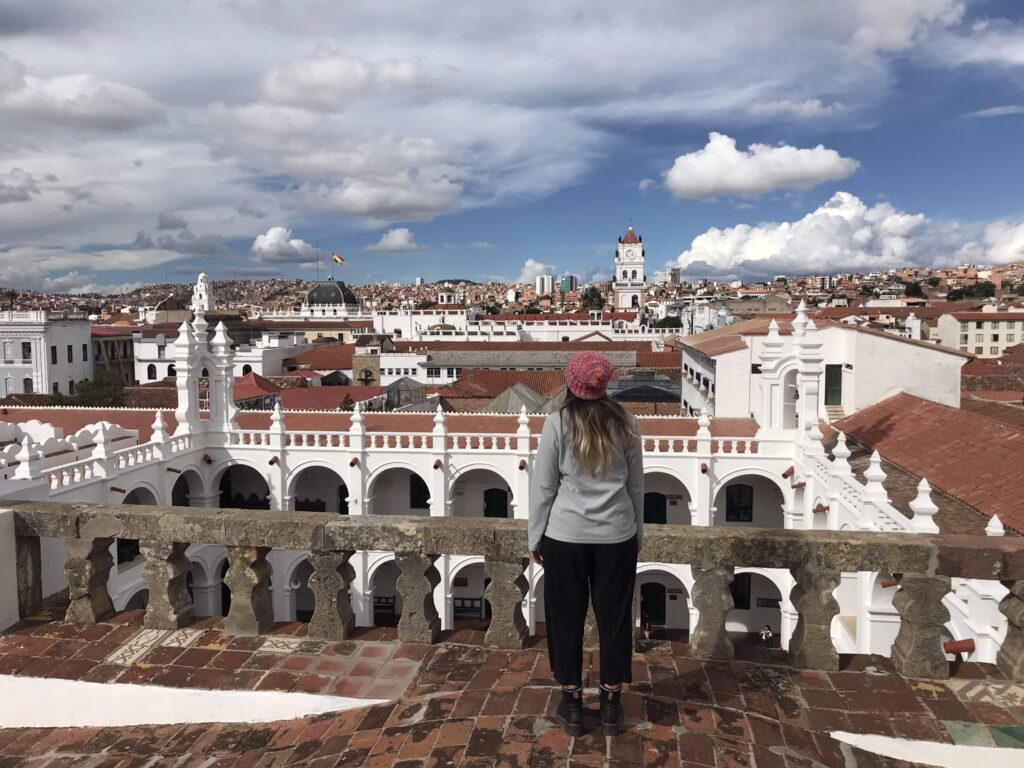
Sucre, the de jure capital of Bolivia, was built with the incredible wealth from the silver mines at Potosi. There is a distinct European influence in the architecture of the city, which is known as Bolivia’s ‘white city’. Sucre is a popular Bolivia travel destination for people looking to learn Spanish and there is usually a small gringo presence in town because of this, the city has a youthful, Westernised feel which is very different from La Paz.
Accommodation
Colors House Hostel – they offer Spanish lessons for a very good price
Foodie Places
- WOW Healthy Food Coffee – great place for breakfast/lunch, it’s not the easiest to find as it is in the same entrance as the nearby hostel however the perseverance is worth it
- Cafe Restaurant Florin – the best food we had in Bolivia, try the Mexican board or loaded fries with chicken, I promise you won’t be disappointed
- Salteñeria El Patio – we were told by Alvaro our walking tour guide that that this is the best place to try saltenos, the local specialty which is similar to an empanana but with slightly sweeter pastry
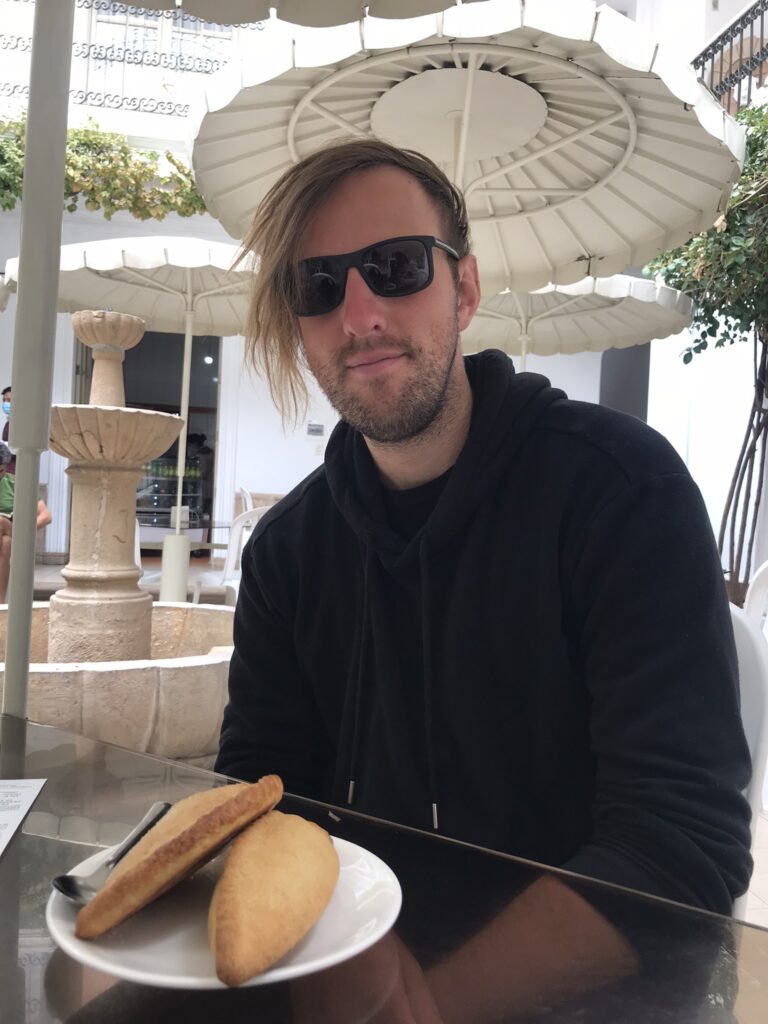
Dan digging into saltenos
- La Ermita de San Francisco – you can sit on the roof of San Francisco church and enjoy a coffee or light snack, it’s a very unique place for a cafe near to Sucre’s famous ‘liberty bell’
Activities
- Free walking tour: Hidden facts and forgotten lore with Daniel Alvaro – Daniel was very knowledgeable so I wanted to give him a plug, he talked about a lot of dark subjects which I found fascinating
- Parque Simon Bolivar – keep an eye out for the mini Eiffel tower
- Mirador de La Recoleta – great views of the city
- Freedom House – this is the place that Bolivia’s independence was signed and contains historic rooms and information about the country’s history and former leaders. We managed to wrangle a free English guided tour around the museum and it was well worth the time spent
- Treasure Museum – a huge variety of jewels and precious stones, they also have a gift shop where you can buy the gems on display. You need to wait for a guided tour, we took a Spanish tour and didn’t all the explanations however we got the gist of it, and the highlight is looking at the gems
- Iglesia de San Felipe Neri – instagramable photo-op on the roof, the white walls and bell tower on the roof alongside spectacular views of the city make this a photogenic destination. This is somewhat hard to find, you have to knock on the door of the nearby school which is attached to the church in order to gain entry to the church and rooftop. Ask a local if you are not sure.
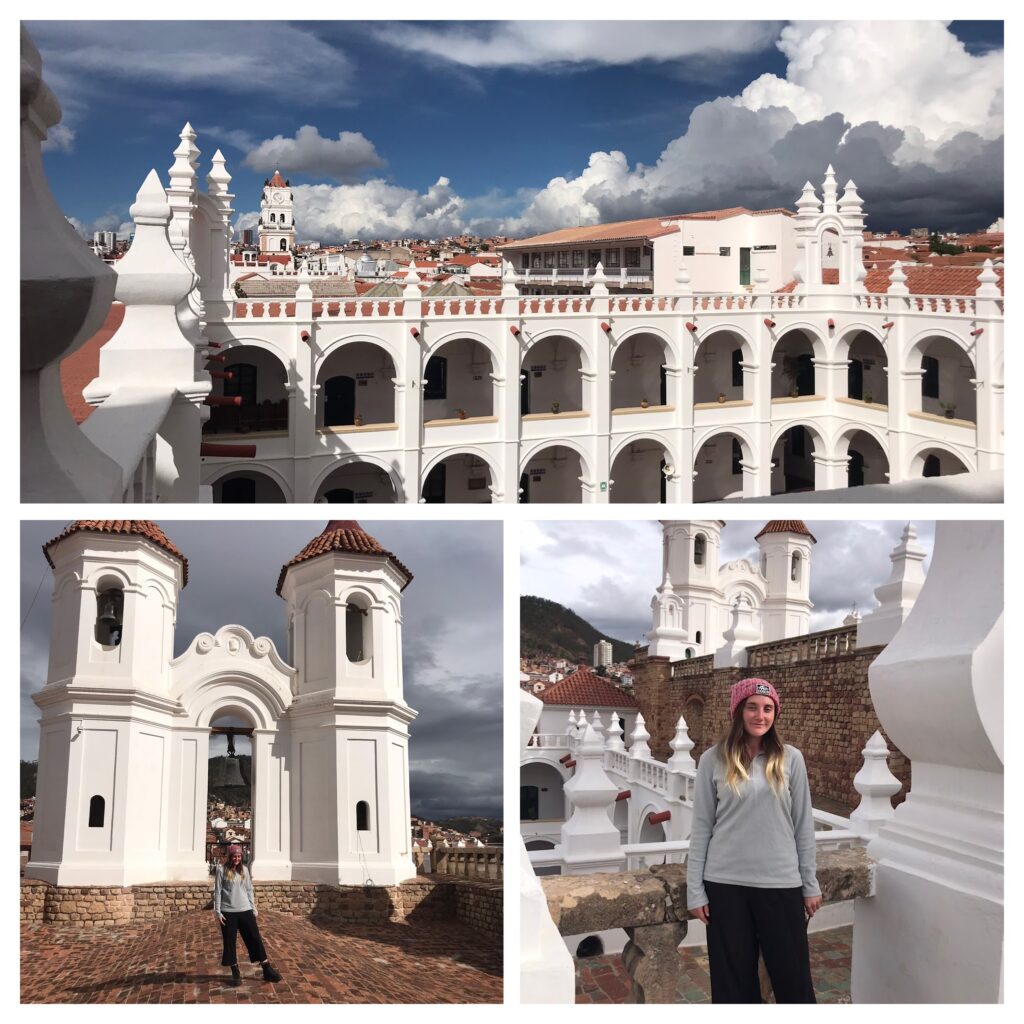
The dazzling San Felipe Neri church
Potosi
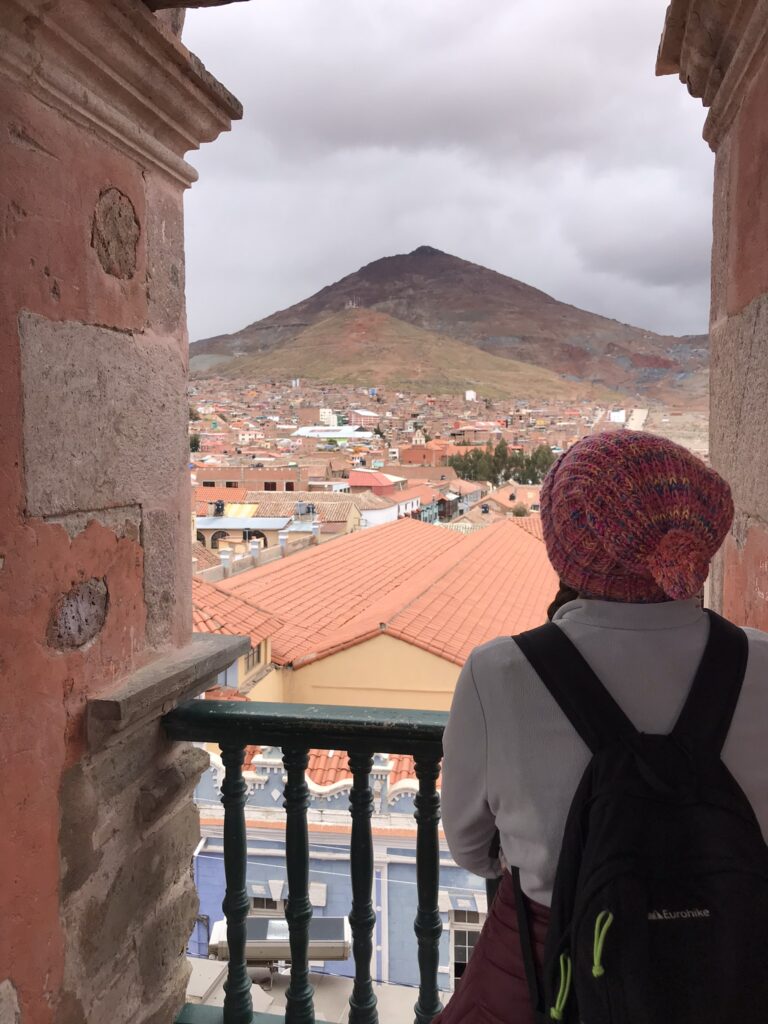
In the shadow of the ‘mountain that eats men’ is Potosi. Once the richest place in the world, this city is now one of the poorest in Bolivia and a relic of the colonial silver rush. The Bolivian government ordered the closure of the mine decades ago as it was deemed to be dangerous and economically unviable, the mountain has been mined so much that it is like a block of swiss cheese and at serious risk of collapse however some miners still make the perilous journey under the Earth’s crust to eek a living mining less precious metals such as zinc and nickel. The miners, with few other prospects, formed a co-operative with the meagre profit pooled and shared amongst them. Daily life for these miners is grim. Tour companies offer guided tours in the mines which is one of the most common activities for visitors to Potosi, however the tours can be dangerous as runaway mine carts come hurtling down the narrow, dark passageways and have been known to injure curious tourists. Health and safety is pretty much non-existent here. There is also a debate about whether it’s unethical for gringos to gawk at miners who face very perilous working conditions for little reward. It’s worth mentioning you have to bring gifts for the miners if you visit, such as dynamite (yes, you can actually buy dynamite!), cigarettes or alcohol. The miners have to provide all their own tools so tourists helping them out might not be such a bad thing and may also provide a morale boost for them. However it’s also debatable how much of the money from tours actually goes to the miners themselves or is retained by the tour companies, and some consider it to be exploitative dark tourism. It’s up to you whether you want to go on these mine tours, there clearly are pros and cons to bear in mind when making your decisions. We decided not to visit the mines, but this was partly due to Dan’s mobility issues as he was hobbling around and his ankle was swollen up after falling down the stairs in La Paz.
The town itself is nice to explore with many historical buildings including the National Mint of Bolivia and Torre de la Compañía de Jesús (good view from the top). It is necessary to join a guided tour of the mint, we were the only English speakers in the group but the lady conducting the tour went out of her way to explain everything to us separately in English which was a nice touch.
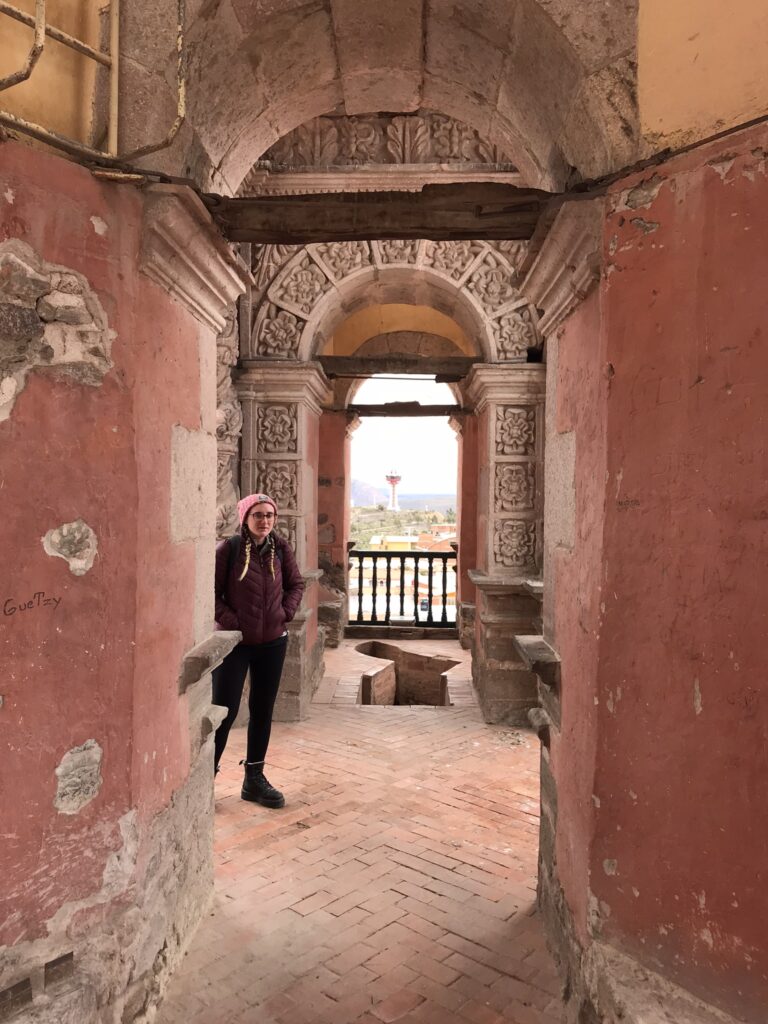
In the bell tower of Torre de la Compañía de Jesús
While resting in the main square (Plaza Principal 10 de Noviembre) we noticed that some mischievous youngsters who had finished school were playing pranks by spraying each other and other unsuspecting kids with shaving foam. As more kids appeared this escalated into a full-on, city-wide shaving foam fight with entrepreneurial guys appearing from the woodwork with cans of shaving foam for sale and anyone in eyeshot becoming fair game for a spraying, teenagers, adults and random passers-by getting involved too and kids even conducting ‘drive-by’ sprayings from their parents cars. We ended up getting pulled into it as well. I’m not sure if this is a regular occurrence but we left for Uyuni covered in foam.
It’s worth mentioning that the bus to Uyuni goes from the old bus terminal (marked Exterminal or Antigua terminal on google maps, location -19.57833701799659, -65.76490063568318) rather than the eerie, cavernous new bus station (Nueva terminal) that you will be dropped off at if heading to or from Sucre.
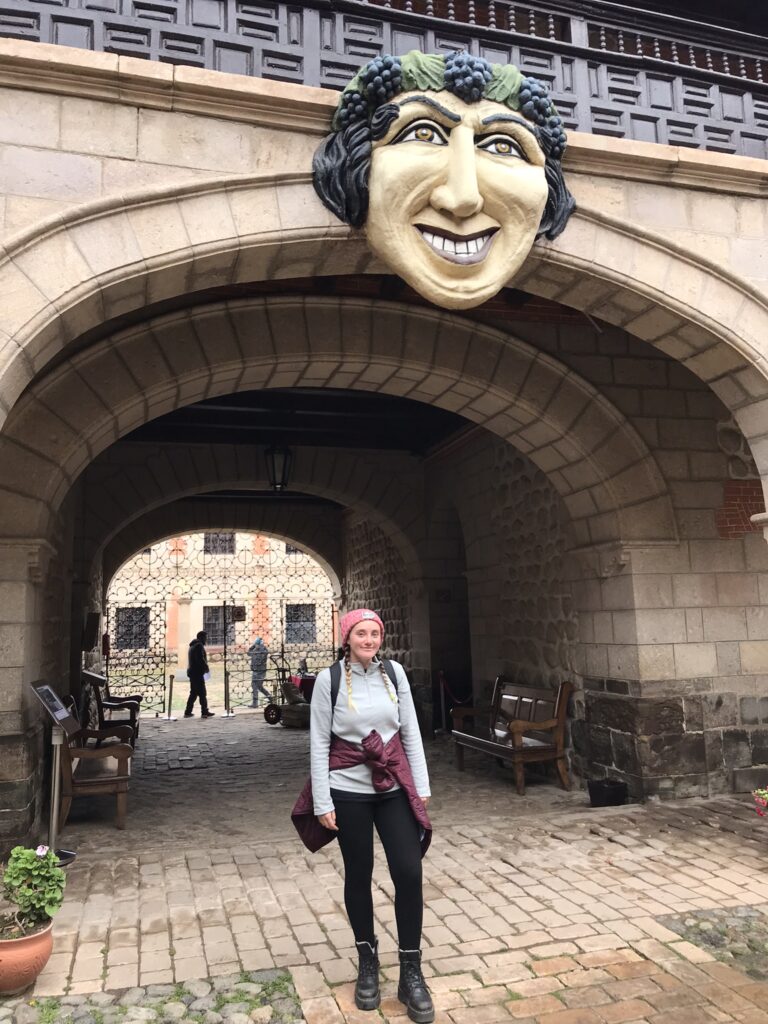
Exploring the National Mint of Bolivia – this bizarre and garish face is the symbol of the mint
Foodie Places
Cafe Pub 4060 – hands down the best place to eat in Potosi, we were surprised by how modern it was here and enjoyed drinking the local beer.
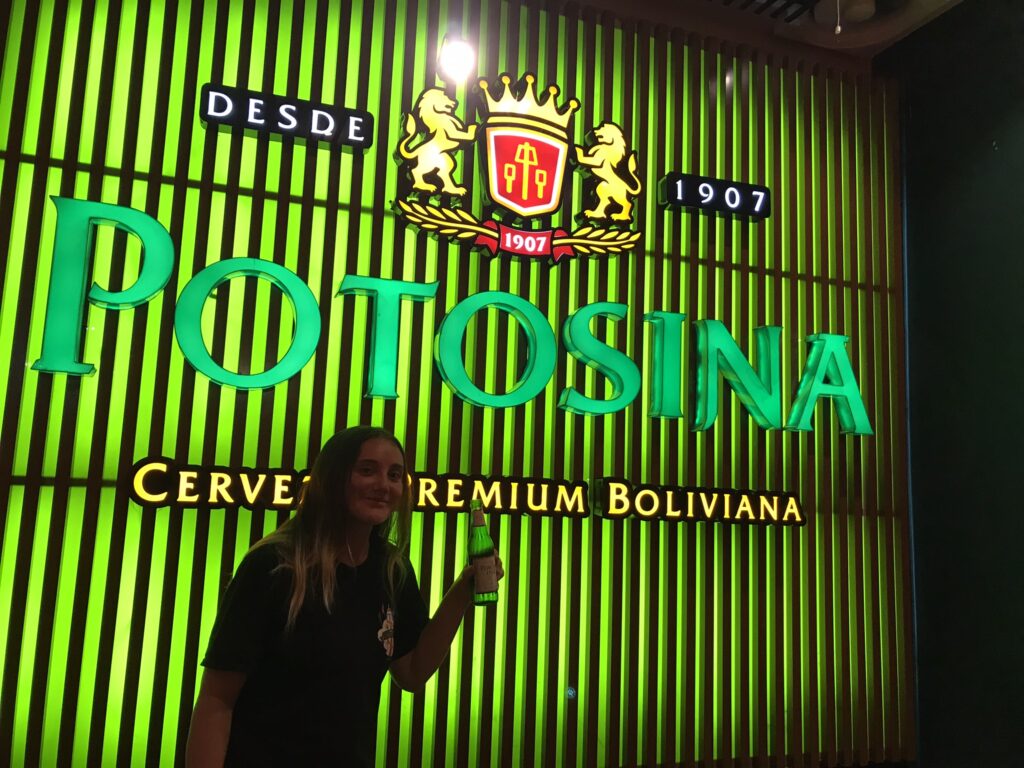
Drinking Potosina in Potosi
Accommodation
Hotel Santa Teresa – great location just down the street from the National Mint of Bolivia, due to a lack of options in Potosi this was the nicest and most expensive hotel we stayed in in our whole time in Bolivia.
Uyuni
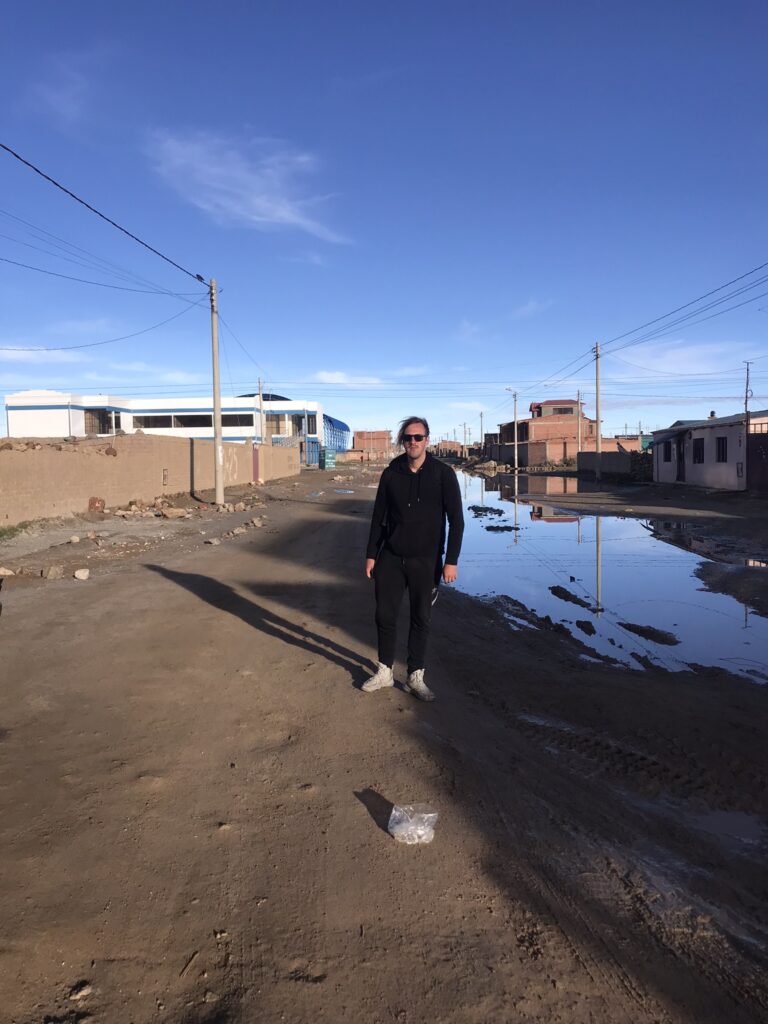
Warts and all – the town of Uyuni during the rainy season
The gateway to the Uyuni Salt Flats, the town Uyuni reminded us of the wild west, with dirt roads and a foreboding atmosphere. The streets did not have adequate drainage and when we arrived most of the town was flooded, with enormous puddles and the dirt roads having mostly turned to sandy, muddy slush. We found that there were many stray dogs roaming the streets here, and unlike many other parts of South America these dogs did not seem too friendly. Uyuni is not a place to overstay your welcome, it’s a place to stay for one night before traveling to the salt flats the next day.
Accommodation
Asian House – a bit out of town, you have to navigate dirt roads, dead ends and hostile dogs to get here. I’m not sure why it is called Asian House as there did not seem to be anything Asian about it, but it was clean and good quality for the price.
Foodie Places
- Donna Isabella – good pizzas
- Tika – a more upmarket establishment with higher prices, one of the only nice restaurants in town serving mondongo and other local dishes as well as some more European dishes
Activities
Salt Flat Tour (3 days) with Skyline Traveller – there are many tour companies in Uyuni, after shopping around a bit we picked Skyline because it was highly rated and we weren’t disappointed. The food was much better than other groups we saw and none of us got ill from the food, the accommodation and pace of the tour was great and the guide was very friendly.
Tips for the Uyuni Salt Flats Tour
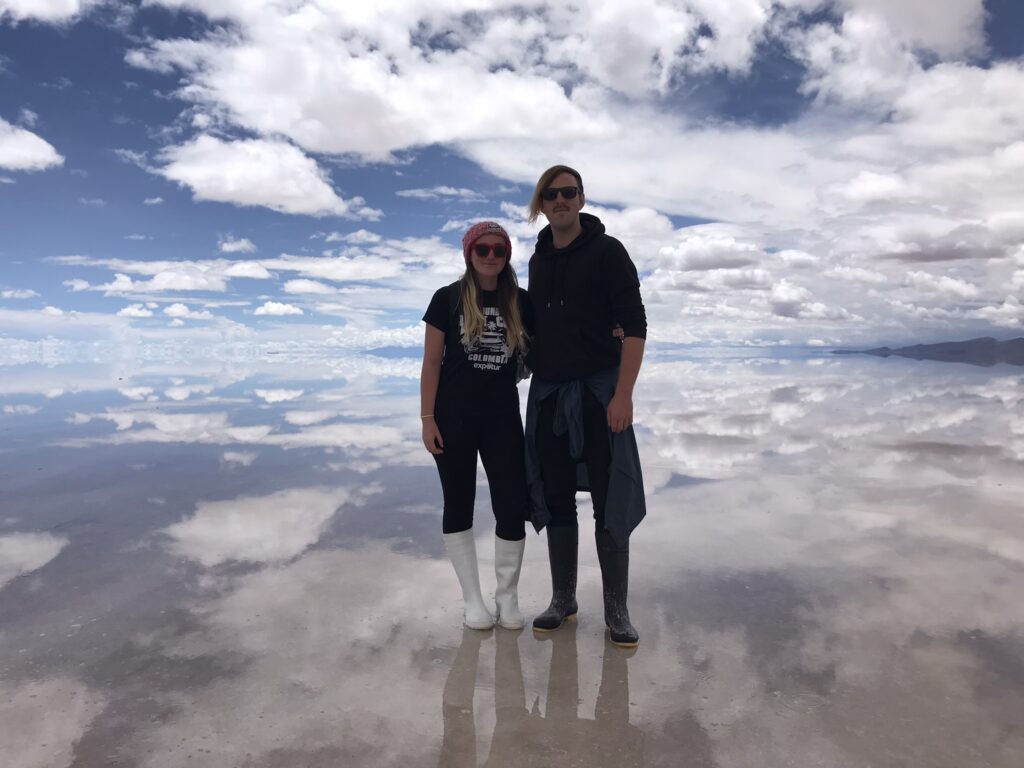
The Salt Flats will either be dry or wet depending on the season you visit. During the rainy season you will experience the mirror effect (like us) or when the weather is drier, a more crusty appearance to the Salt Flat. Both experiences are different – we weren’t able to visit Cactus Island due to the water level on the Salt Flats, so there are pros and cons to visiting during each season. Personally I was blown away by the mirror effect, seeing the clouds reflected on the surface of the water and watching the sunset on the Salt Flat, and I think this would probably be a better experience than visiting when the ground was dry, but you can make up your own mind.
You won’t be the only group on the Salt Flat, even though photos make it look like a really secluded location there will be many other groups on the salt flat at the same time. Try not to be disappointed by this, the salt flat is a huge area and your guide will help you get the best photos, sometimes using props like toy dinosaurs for perspective shots, trust their knowledge.
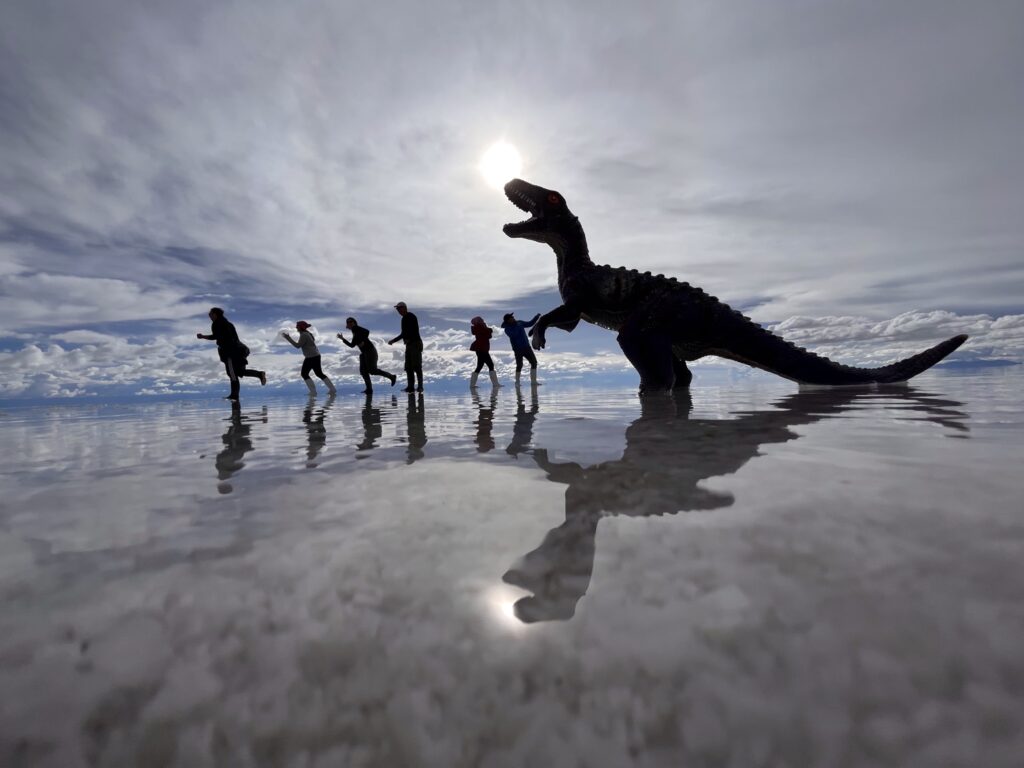
Stock up on supplies in Uyuni that you’ll need for the Salt Flat tour including toilet roll, water and snacks.
I highly recommend (if possible) booking the tour in person when you arrive in Uyuni as you will be able to get a better price this way, however the company we used (Skyline Traveller) does accept online bookings too. There are cash machines in the town centre of Uyuni if the tour company you want to book with asks you to pay in cash, which is common.
We paid extra (around £190 each in total) for a private room for the 3 day tour, as it turned out each couple in our tour group got a private room anyway however by paying extra we did get the best rooms at each overnight stop, on one night we were the only couple to get a private bathroom which I was over the moon with. This could just be luck though, as the tour company does warn that some rooms might be shared. There were 6 people in total in our group, which was ourselves, a couple from Venezuela and a father and daughter from Brazil. Our guide spoke in both English and Spanish.
If heading to Chile after Bolivia I recommend getting dropped off at the Chilean border at the Avaroa-Hito Cajones crossing, from there you can get onward travel to San Pedro de Atacama, tour companies can organize this for you for a small extra charge.
Be mentally prepared for early mornings and a lot of off-road jeep travel, pack motion sickness medication if this is something that affects you.
The altitude may affect you during the tour, pack medication or coca leaves. We had been traveling for weeks through the altiplano so were fine, however a Brazilian doctor in our group was very sick with the altitude so we saw the effects first-hand.
Don’t expect wifi or internet access when staying in accommodation in the national park or on the Salt Flats.
The accommodation will be very basic; if you have a sleeping bag or extra blankets, pack this. It gets cold at night and the blankets provided might not be very efficient. You can rent a sleeping bag in Uyuni (if returning) or from the tour company. We didn’t need one in the end but had one as a backup.
And remember, the Salt Flats tour isn’t just of the Salt Flat, you might also get to visit the Train Cemetery, various lagoons in the national park with flamingos, geysers, hot springs and interesting rock formations such as the Dali desert.
The Uyuni Salt Flats tour was one of our favourite experiences in South America, the three-day tour was well worth the price and also provided us with onward transport to Chile. If you are considering booking then do it! You can also get a tour departing from San Pedro de Atacama in Chile, this would presumably take in most of the same sights but in reverse order, and would likely be a lot more expensive due to the astronomical prices in San Pedro.
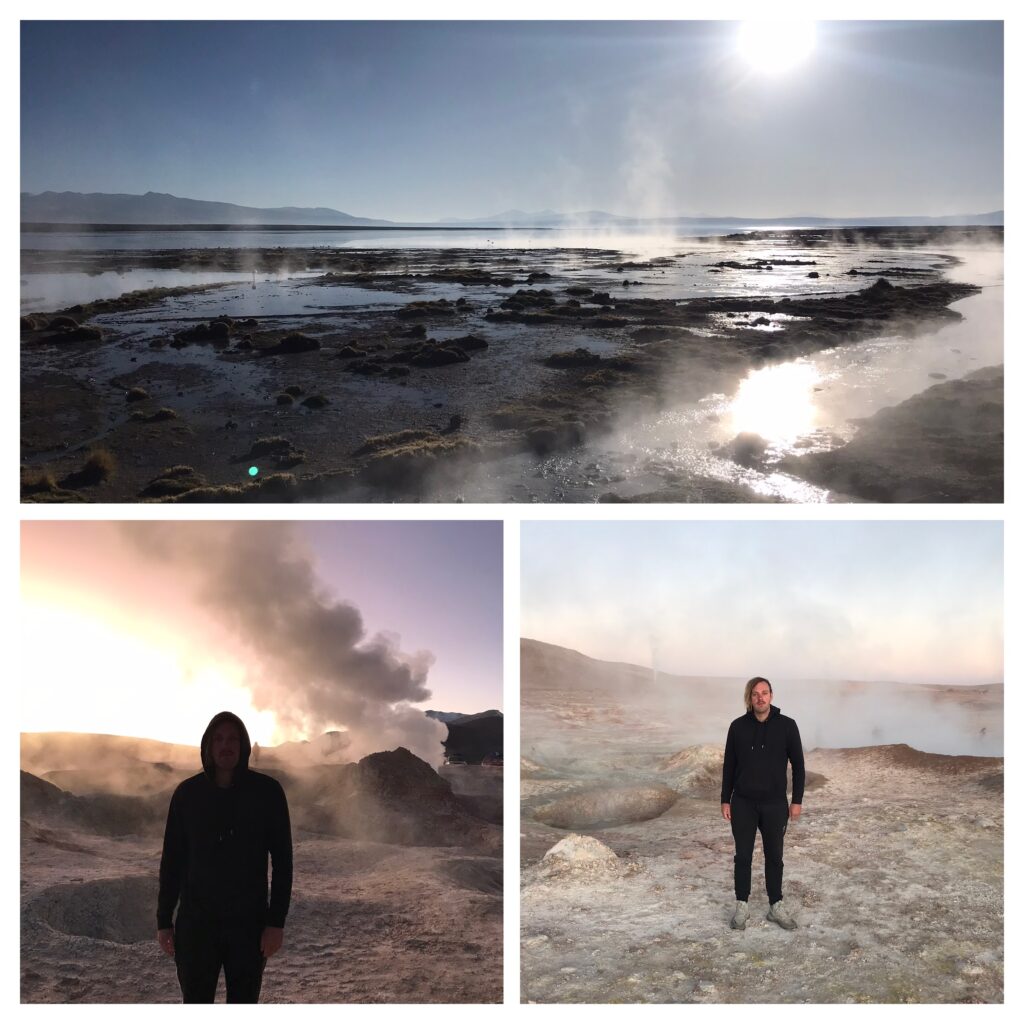
Geyers and hot springs on the 3rd day
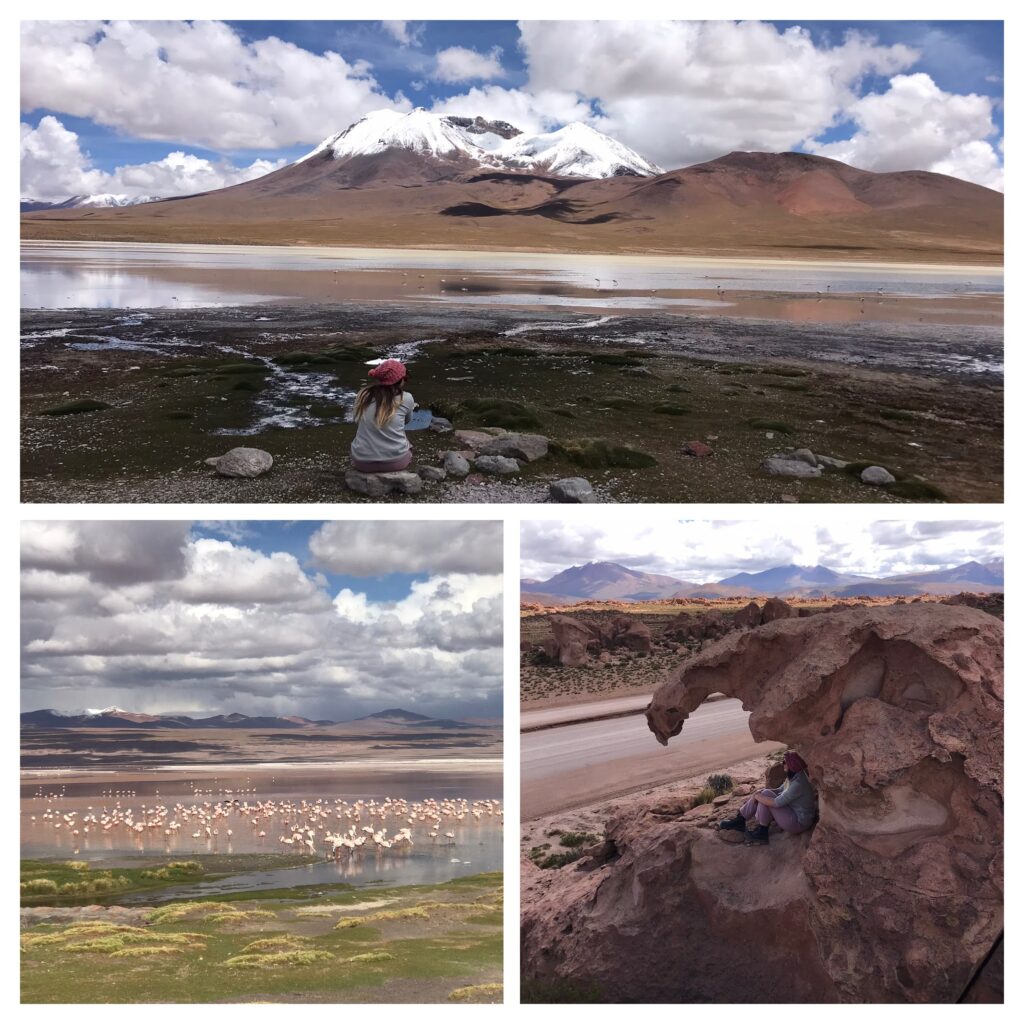
Driving through the National Park, we stopped at many lagoons along the way, some with flamingos
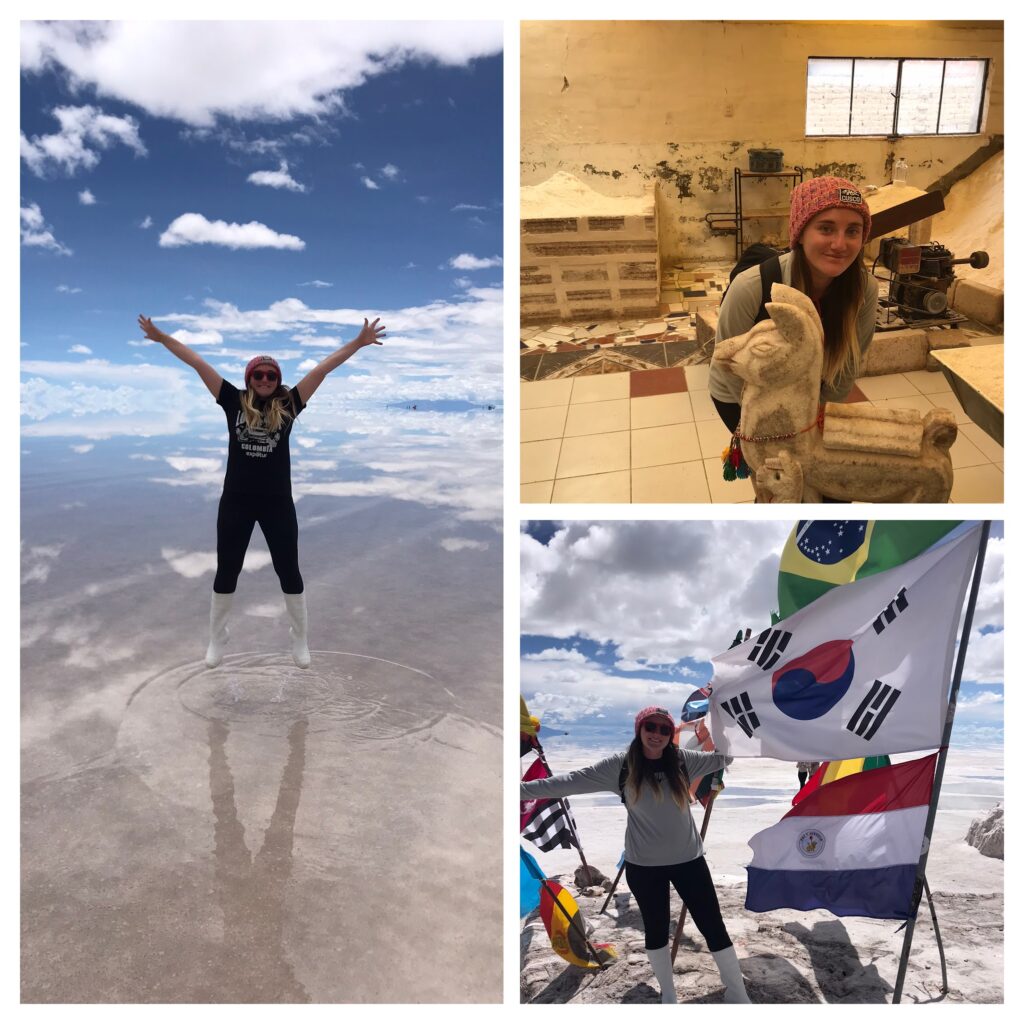
Visiting the Salt Hotel and posing with some salt sculptures

Train Cemetery – this is located just outside Uyuni
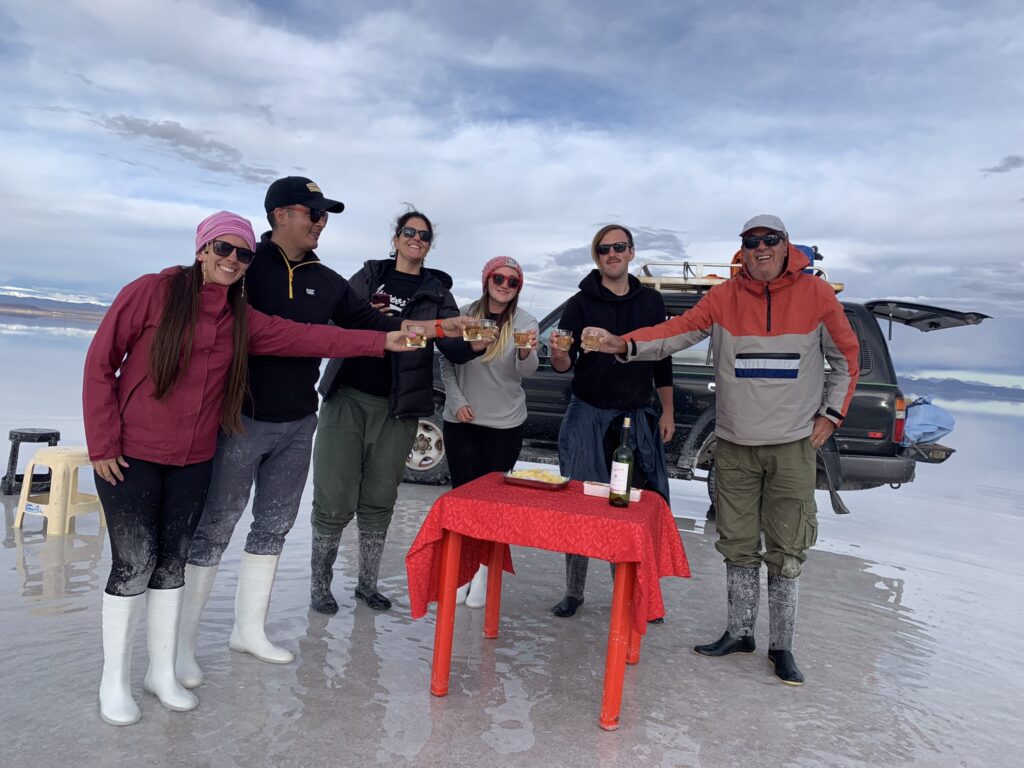
Our Uyuni Salt Flat group – we were the only native English speakers in our group, our group compromised of 2 Venezuelans, 2 Brazilians and us. We tried to communicate in Spanish and managed to get along quite well
